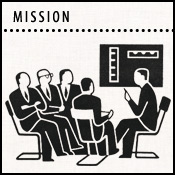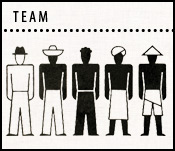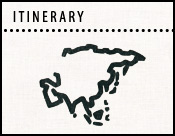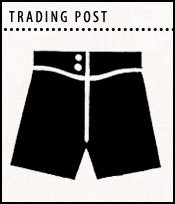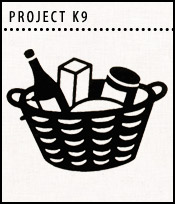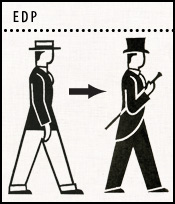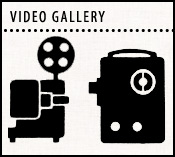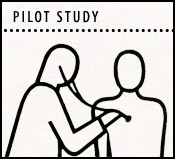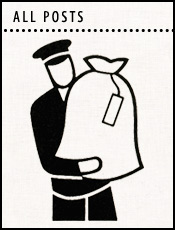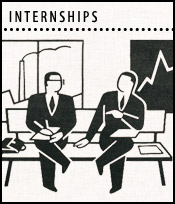February 12th, 2010
A Host of New Flavors in Singapore
 The sun rose in Singapore but was unable to find its way into our room at the RuckSack Inn, namely due to the lack of windows. But what it lacked in windows, it easily made up for in silence, cleanliness, and sweet smells. In preparation for our arrival, the management had placed a bowl of fragrant water over a tea candle, which kept the room smelling faintly of sandalwood. We slept like the dead, and when I awoke, I was quite surprised to the find the day well underway and the other residents busily making piece after piece of toast in the common room. We followed suit. And with stomachs full of toast and precious muddy Indonesian coffee, which we had imported, we took to the streets.
The sun rose in Singapore but was unable to find its way into our room at the RuckSack Inn, namely due to the lack of windows. But what it lacked in windows, it easily made up for in silence, cleanliness, and sweet smells. In preparation for our arrival, the management had placed a bowl of fragrant water over a tea candle, which kept the room smelling faintly of sandalwood. We slept like the dead, and when I awoke, I was quite surprised to the find the day well underway and the other residents busily making piece after piece of toast in the common room. We followed suit. And with stomachs full of toast and precious muddy Indonesian coffee, which we had imported, we took to the streets.
Traffic was certainly different in this country, and we rode between large shiny cars and buses that hummed by. As a general rule, we found the traffic to be very polite, changing lanes when possible to give us space, and providing us with little toots of the horn alerting us to their position.
The city itself was large and vertical. Huge structures of glass and concrete loomed all around us as we wheeled through the financial district toward our first waypoint: CitiBank. We were very excited to use some much needed currency services there, and were sorely disappointed when we discovered that Citibank in the U.S. is an entirely different operation from Citibank in Singapore. The very friendly women at the front desk were unable to even pull the current balance on our account. With regret, they explained that for the whole of AsiaWheeling, deposits would be an impossibility. And with meek apologetic smiles, they showed us to an ATM, from which we would be able to withdraw cash and do nothing else. Of some consolation, however, was the presence of complimentary cookies and coffee in the lobby. “Don’t mind if I do…†I thought to myself.  It will have to be HSBC for AsiaWheeling III.
Back on the cycles and freshly laden with cash, we were beginning to get the hang of this city. It was a place for highway speed calls, to be sure. Traffic was quick, and mopeds were almost nonexistent. Cycles were a little bit more common, but those too were rare. So we wheeled on through canyons of metal and glass amidst a light traffic of trucks, vans, and cars.
We were careful to obey traffic laws to the best of our ability, knowing that fines would be steep for any infraction we were convicted of. For instance, a simple case of jaywalking would result, if caught, in a $5,000 fine. Not to be taken lightly, dear reader.
Scott had purchased a Singaporean SIM card, and called a radio waypoint outside an overpriced Italian steakhouse, to get in contact with the local Dahon distributor. This was an operation by the name of Speed Matrix. We had been put in touch with it thanks to Dahon’s California headquarters, where we had picked up the Speed TRs.
We were badly in need of a tune-up, and Speed Matrix responded enthusiastically. It turned out that the demand for folding bicycles in Singapore had grown so much that Speed Matrix had recently transitioned to the role of wholesale distributor, supplying folding cycles and parts to no less than eight retail shops. The owner, a fine chap by the name of Allen, gave us directions to one of his top shops, and we immediately set it as the next waypoint.
Bottles of water in this city, unfortunately, proved very expensive — 10-20 times what we had paid in Indonesia — perhaps because here, in a land where one can drink from the tap, bottled water is a luxury, a form of conspicuous consumption. Regardless, our regimen of strict hydration was hampered by its burden on the budget.
The journey to the shop, known by the unassuming name of “My Bike Shop†was somewhat longer than expected, in part due to circuitous routing reliant upon directions from pedestrians and the mistaken assumption that streets might continue in the same direction for any appreciable distance in this most logical but somewhat difficult to navigate city.
We found ourselves forced to call a number of waypoints on the wheel. The first was at a 7-11 kiosk outside a posh mall, where we purchased some barley lime drinks, swearing to refill the bottles with tap water. Outside the 7-11, we engaged in lengthy conversation with a Greek man. The Greek fellow regaled us for some 30 minutes with stories of Greece during the second world war, and his experience working in the merchant marine, visiting America during the 1950s, and other wild ports of call from his youth.
After we bade goodbye to the Greek fellow, we quelled the urge to spend the next hour reading about WWII on the Wikireader, and took to the streets. We had made some significant progress westward when the hunger hit. Luckily, directly on the other side of the highway we were on was a roadhouse type restaurant called the Union Farm Eating House. It looked reasonably down-home, so we parked the bikes and strolled in. The specialty, it seemed, was paper-wrapped chicken, and we simply asked our waitress to emulate the order of the adjacent table, which contained two Singaporean gentlemen, positively raging on their paper-wrapped chicken, oscillating between scarfing down large pieces, spitting bones, and slurping noodles from nearby plates.

Unfortunately, the food turned out to be lackluster. The chicken was flavored in a way startlingly similar to Jimmy Dean Sausages, and the greens and noodles proved to be cold and uninspiring. There was some slight redemption in the fact that they provided us with a huge dented aluminum can to deposit our bones in, but then we were hit with the bill, which proved even more uninspiring. An important lesson about Singapore: things are not cheap here.
While we were finishing up the meal, Scott got a call from Allen at Speed Matrix. It turns out they were actively expecting us, so we quickly paid the piper and hit the road.
Here I must take a moment to disclose that SpeedMatrix and My Bike Shop are partners of AsiaWheeling and have underwritten the cost of bicycle maintenance for this leg of the journey. The views expressed below, however, are those of AsiaWheeling alone.
The remainder of the ride was straight forward, with frequent calls of “highway speeds.†We arrived at My Bike Shop sweaty and triumphant, and strolled through the door into a frigidly air conditioned wonderland. Surrounding us on all sides were folding cycles of every shape and size. From folding full suspension mountain bikes, to hyper-light custom-built folding racing bikes, they had it all. We introduced ourselves to the owner, Tan, a fine gentleman, Scuba instructor, and folding bicycle guru.

He gave us an indepth tour of the store, introducing us to the newest models and technologies, detailing his personal modifications of some of the bike’s gearing systems, and offering us coffee (he obviously knew the way into AsiaWheeling’s heart). Tan agreed to help us in realigning and tuning our cycles, and to provide us with a spare tri-tool, to replace one we had lost in Candidasa.
Tan provided best practices for checking the Speed TR in cargo when flying with it. Â This included some low-cost foam surrounding the rear transmission, bound with cable ties. Â Removing the black Sram component, which clicks onto the planetary gear shaft was also a brilliant innovation we had not yet considered.
We also arranged to rent a cycle from him to to be used by the illustrious Mr. David Miller, Dive Master for AsiaWheeling on the following day’s wheel. Feeling quite delightful after our warm welcome and nicely caffeinated after the espressos that Tan had quite graciously offered us, we took back to the street for a very high voltage return to downtown.

We covered the distance in about half the time aided by our renewed energy and Tan’s superior directions.
Back in the city, we slowed our pace, and gaped in awe at the immensity of the structures around us, while we patiently waited at stoplight after stoplight.
The sky was beginning to light up orange and purple and by the time the hunger hit, we were back in Chinatown. We settled on a return to the same market that we had explored the previous night. We indulged in a meal of street food, sampling items from the hundreds of food stalls that clogged the streets.
Our dinner consisted of fried squid on a stick, freshly steamed pork buns, sausages with pickle and mustard, and a few plastic bags of dried coconut and mango. Truly delightful.
Scott then left to meet some friends from his workplace in Japan, while I prepared for the arrival of Mr. David Miller. It was not until well after midnight, clogged with exhaustion from the day’s wheel and strolling back from the corner store where I had purchased some modest provisions, that I heard a familiar voice call forth from a nearby cab. I was quite surprised to find none other than Mr. Miller himself, waving me over. I was quite overjoyed at our reunion and for a brief time forgot completely about my exhaustion, filled with a renewed excitement for all that lay before us.
Loading image
Click anywhere to cancel
Image unavailable




































































































